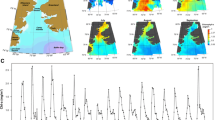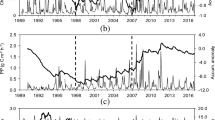Abstract
In this work, we make use of satellite estimates of chlorophyll a, photosynthetically active radiation and sea surface temperatures, to compute regional estimates of primary production integrated throughout the euphotic layer for the Algero-Provençal Basin, by means of a modified version of the vertically generalized production model. The seasonal and interannual variability of the primary production has been analysed over the decade 1997–2007. Empirical orthogonal functions analysis has been applied to decompose the variability of the primary production dataset in orthogonal modes of variability. The seasonal signal is distributed between the two first modes of variability, temporally shifted each other and respectively related to the northern (early spring) and the southern (winter) part of the basin. We found a minimum of the annual production in 2003, when a summer heatwave strongly enhanced the stratification of surface waters, further limiting the injection of nutrients into the surface layers. Maxima in the annual series are found in 1999 and 2005, due to two particularly intense and extended (in space) spring-blooms in the northern part of the basin. These two maxima, clearly identified in space and time by EOF analysis (EOF1 and EOF3), are related to strong mistral-wind interannual events occurring during winters of 1999 and 2005, preceding the blooms by some few months. We found that these production maxima are due both to a more intense production in the usual blooming area (shown by EOF1–PC1) as well as to an exceptional local production in the eastern side of the basin, off the Corsica western coasts (EOF3–PC3). Previous observations of exceptional deep-water formation events in 1999 and 2005, with easterly spots close to the primary production-observed anomalies, and the meridional character of the mistral 1999 and 2005 peaks both support the idea that such eastern PP interannual maxima would be actually due to exceptional production more than to an easterly advection of biomass from the usual bloom area. Finally, the potential link of the observed features with large-scale atmospheric forcing is discussed, and a potential relation of such interannual events with the East Atlantic pattern is drawn.










Similar content being viewed by others
References
Antoine D, Andrè J, Morel A (1996) Oceanic primary production: Ii. Estimation at global scale from satellite (coastal zone color scanner) chlorophyll. Glob Biogeoch Cycles 10:57–69
Behrenfeld MJ, Falkowski PG (1997) Photosynthetic rates derived from satellite-based chlorophyll concentration. Limnol Oceanogr 42(1):1–20
Behrenfeld MJ, Siegel DA, O’Malley RT, Maritorena S (2009) Global ocean phytoplankton. B Am Met Soc 90:S68–S73
Bethoux J, Durieu de Madron X, Nyffeler F, Tailliez D (2002) Deep water in the western Mediterranean: peculiar 1999 and 2000 characteristics, shelf formation hypothesis, variability since 1970 and geochemical inferences. J Mar Syst 33:117–131. doi:10.1016/S0924-7963(02)00055-6
Bosc E, Bricaud A, Antoine D (2004) Seasonal and interannual variability in algal biomass and primary production in the mediterranean sea, as derived from 4 years of seawifs observations. Glob Biogeoch Cycles 18:GB1005
Bouzinac C, Font J, Johnny J (2003) Annual cycles of sea level and sea surface temperature in the western mediterranean sea. J Geophys Res 108:3059
Bricaud A, Bosc E, Antoine D (2002) Algal biomass and sea surface temperature in the mediterranean basin—intercomparison of data from various satellite sensors, and implications for primary production estimates. Remote Sens Environ 81:163–178
Doney SC (2006) Oceanography—plankton in a warmer world. Nature 444:695–696
Eppley RW, Stewart E, Abbot RM, Heyman V (1985) Estimating ocean primary production from satellite chlorophyll, introduction to regional differences and statistics for the southern california bight. J Plankton Res 7:57–70
Falkowsky PG (1981) Light-shade adaptation and assimilation numbers. J Plankton Res 3:203–216
Font J, Puig P, Salat J, Palanques A, Emelianov M (2007) Sequence of hydrographic changes in nw mediterranean deep water due to the exceptional winter of 2005. Sci Mar 71(2):339–346
Garcon VC, Oschlies A, Doney SC, McGillicuddy D, Waniek J (2001) The role of mesoscale variability on plankton dynamics in the north atlantic. Deep-Sea Res, II 48:2199–2226
Henson SA, Sarmiento JL, Dunne JP, Bopp L, Lima I, Doney SC, John J, Beaulieu C (2010) Detection of anthropogenic climate change in satellite records of ocean chlorophyll and productivity. Biogeosciences 7(2):621–640. doi:10.5194/bg-7-621-2010. Available at http://www.biogeosciences.net/7/621/2010/
Isern-Fontanet J, Font J, Garcia-Ladona E, Emelianov M, Millot C, Taupier-Letage I (2004) Spatial structure of anticyclonic eddies in the algerian basin (mediterranean sea) analyzed using the okubo-weiss parameter. Deep-Sea Res, Part 2, Top Stud Oceanogr 51:3009–3028
Jacques G, Minas H, Minas M, Nival P (1973) Influence des conditions hivernales sur les productions phyto et zooplanctoniques en mèditerraneè nord-occidentale. II: Biomasse et production phytoplanctonique. Mar Biol 23:251–265
Kameda T, Ishizaka J (2005) Size-fractionated primary production estimated by a two-phytoplankton community model appllicable to ocean color remote sensing. J Oceanogr 61:663–672
LaViolette PE, Tintoré J, Font J (1990) The surface circulation of the Balearic Sea. J Geophys Res 95:1559–1568
Levy M, Memery L, Madec G (1998) The onset of a bloom after deep winter convection in the northwestern mediterranean sea: mesoscale process study with a primitive equation model. J Mar Syst 16:7–21
Levy M, Memery L, Madec G (1999) The onset of the spring bloom in the medoc area: mesoscale spatial variability. Deep-Sea Res, I 46:1137–1160
Levy M, Memery L, Madec G (2000) Combined effects of mesoscale processes and atmospheric high-frequency variability on the spring bloom in the medoc area. Deep-Sea Res, I 47:27–53
Lionello P, Galati M (2008) Links of the significant wave height distribution in the mediterranean sea with the north hemisphere teleconnection patterns. Adv Geosci 17:13–18
Lionello P, Malanotte-Rizzoli P, Boscolo R (2006) Mediterranean climate variability. Elsevier, Amsterdam
Lohrenz SE, Wiesenburg DA, DePalma IP, Johnson KS, Gustafson J, Daniel E (1988) Interrelationships among primary production, chlorophyll, and environmental conditions in frontal regions of the western mediterranean sea. Deep-Sea Res 35(5A):793–810
López Garciá MJ, Millot C, Font J, García-Ladona E (1994) Surface circulation variability in the Balearic Basin. J Geophys Res 99:3285–3296. doi:10.1029/93JC02114
Lorenz E (1956) Empirical orthogonal functions and statistical weather prediction. Tech. rep., Department of Meteorology, Massachusetts Institute of Technology, Cambridge
Marullo S, Guarracino M (2003) La anomalia termica del 2003 nel mar mediterraneo osservata da satellite. Energia, Ambiente e Innovazione 6/03:48–53
McGillicuddy D, Anderson L, Bates N, Bibby T, Buesseler K, Carlson C, Davis C, Ewart C, Falkowski P, Goldthwait S, Hansell D, Jenkins W, Johnson R, Kosnyrev V, Ledwell J, Li Q, Siegel D, Steinberg DK (2007) Eddy/wind interactions stimulate extraordinary mid-ocean plankton blooms. Science 316:1021–1026
MEDOC group (1969) Observation of formation of deep water in the mediterranean sea. Nature 227:1037–1040
Millot C (1985) Some features of the Algerian current. J Geophys Res 90:7169–7176
Millot C, Gacic M, Astraldi M, La Violette PE (1999) Circulation in the western mediterranean sea. J Mar Syst 20(1–4):423–442
Mizobata K, Saitoh SI (2004) Variability of bering sea eddies and primary productivity along the shelf edge during 1998–2000 using satellite multisensor remote sensing. J Mar Syst 50:101–111
Moran XAG, Taupier-Letage I, Vazquez-Dominguez E, Ruiz S, Arin L, Raimbault P, Estrada M (2001) Physical–biological coupling in the algerian basin (sw mediterranean): Influence of mesoscale instabilities on the biomass and production of phytoplankton and bacterioplankton. Deep-Sea Res, I 48:405–437
Morel A (1978) Available, usable, and stored radiant energy in relation to marine photosynthesis. Deep-Sea Res, Part 2, Top Stud Oceanogr 25:673–688. doi:10.1016/0146-6291(78)90623-9
Morel A, Andrè JM (1991) Pigment distribution and primary production in the western mediterranean as derived and modeled from coastal zone color scanner observations. J Geophys Res 96:685–698
Nesterov ES (2009) East atlantic oscillation of the atmospheric circulation. Russ Meteorol Hydrol 34(12):794–800
Olita A, Sorgente R, Natale S, Gaberšek S, Ribotti A, Bonanno A, Patti B (2007) Effects of the 2003 european heatwave on the central mediterranean sea: surface fluxes and the dynamical response. Ocean Sci 3:273–289
Olita A, Ribotti A, Sorgente R, Fazioli L, Perilli A (2011) SLA—chlorophyll-a variability and covariability in the Algero-Provençal Basin (1997–2007) through combined use of EOF and wavelet analysis of satellite data. Ocean Dyn 61:89–102. doi:10.1007/s10236-010-0344-9
O’Reilly JE, Maritorena S, Mitchell BG, Siegel DA, Carder KL, Garver SA, Kahru M, McClain C (1998) Ocean color chlorophyll algorithms for SeaWiFS. J Geophys Res 103:24937–24954. doi:10.1029/98JC02160
Platt T (1986) Primary production of the ocean water column as a function of surface light intensity: algorithms for remote sensing. Deep-Sea Res, Part 1, Oceanogr Res 33:149–163. doi:10.1016/0198-0149(86)90115-9
Platt T, Sathyendranath S (1988) Oceanic primary production: estimation by remote sensing at local and regional scales. Science 241:1613–1620
Preisendorfer R (1988) Principal component analysis in meteorology and oceanography. Elsevier, Amsterdam.
Puillat I, Taupier-Letage I, Millot C (2002) Algerian eddies lifetime can near 3 years. J Mar Syst 31:245–259
Raimbault P, Coste B, Boulhadid M, Benyahia B (1993) Origin of high phytoplankton concentration in deep chlorophyll maximum (dcm) in a frontal region of southwestern mediterranean sea (algerian current). Deep-Sea Res, I 49:791–804
Schroeder K, Ribotti A, Borghini M, Sorgente R, Perilli A, Gasparini GP (2008) An extensive western Mediterranean deep water renewal between 2004 and 2006. Geophys Res Lett 35:18605. doi:10.1029/2008GL035146
Schroeder K, Josey SA, Herrmann M, Grignon L, Gasparini GP, Bryden HL (2010) Abrupt warming and salting of the Western Mediterranean Deep Water after 2005: Atmospheric forcings and lateral advection. J Geophys Res (Oceans) 115:8029 doi:10.1029/2009JC005749
Smith RO, Bryden HL, Stansfield K (2008) Observations of new western mediterranean deep water formation using argo floats 2004–2006. Ocean Sci 4(2):133–149. doi:10.5194/os-4-133-2008. Available at: http://www.ocean-sci.net/4/133/2008/
Steeman-Nielsen E (1952) The use of radioactive carbon (14c) for measuring organic production in the sea. J Cons 18:117–140
Taupier-Letage I, Puillat I, Millot C, Raimbault P (2003) Biological response to mesoscale eddies in the algerian basin. J Geophys Res 108
Turley CM (1999) The changing mediterranean sea—a sensitive ecosystem? Prog Oceanogr 44:387–400
Vignudelli S (1997) Potential use of ers-1 and topex/poseidon altimeters for resolving oceanographic patterns in the algerian basin. Geophys Res Lett 24(14):1787–1790
Acknowledgements
SeaWiFS level 3 (PAR and Csat) data have been furnished by NASA Goddard Space Flight Center, distributed through Ocean Color Web portal (http://oceancolor.gsfc.nasa.gov/). SST data were furnished by the US NODC of the National Oceanic and Atmospheric Administration (NOAA) through ftp server data.nodc.noaa.gov. Wind monthly mean re-analyses fields have been obtained from European Center for Medium-Range Weather Forecasting web portal (http://www.ecmwf.int). Monthly teleconnection pattern indices have been obtained from the NOAA Climate prediction Center, freely available at http://www.cpc.ncep.noaa.gov/data/teledoc/telecontents.shtml. The m_map toolbox for MATLAB is used, freely available at http://www.eos.ubc.ca/rich/map.html.
Author information
Authors and Affiliations
Corresponding author
Additional information
Responsible Editor: Joachim W Dippner
Rights and permissions
About this article
Cite this article
Olita, A., Sorgente, R., Ribotti, A. et al. Pelagic primary production in the Algero-Provençal Basin by means of multisensor satellite data: focus on interannual variability and its drivers. Ocean Dynamics 61, 1005–1016 (2011). https://doi.org/10.1007/s10236-011-0405-8
Received:
Accepted:
Published:
Issue Date:
DOI: https://doi.org/10.1007/s10236-011-0405-8




